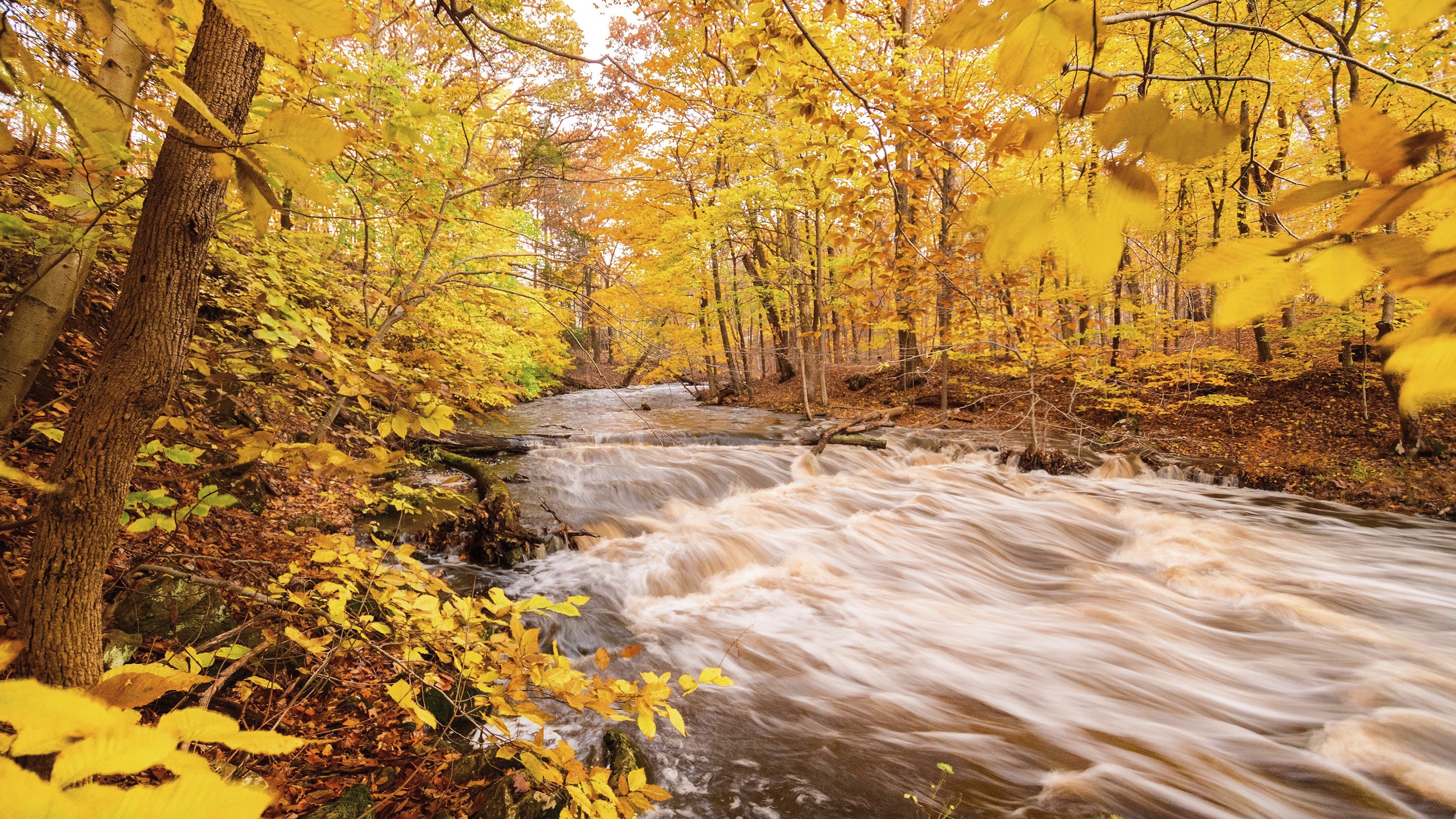In This Issue
- Elect Joe Biden and Kamala Harris
- Be a Clean Water Voter in 2020
- Calling All Clean Water Voters
- Massachusetts Endorsements
- Massachusetts Legislative Roundup
- Carbon Nanotubes
- Tackling PFAS Pollution
- Clean Energy in Connecticut
- Rhode Island's General Assembly Will Be a Bit Greener
- An Interview with Emily Koo
- Download this issue
Elect Joe Biden and Kamala Harris
The stakes have never been higher for our water, health, or climate. We need a President who has a bold vision to address the climate crisis, who follows the science, and who will put our water and communities first. Joe Biden will be that President.
The country can’t afford another 4 months of the Trump administration, let alone another 4 years. In late September, during a trip to California in the wake of devastating climate-fueled fires, the President had the gall to say “it’ll get cooler” and “I don’t think the science knows, actually” during a discussion that mentioned climate change. That is a stunning amount of deliberate ignorance from the President.
That alone should make him unfit to serve. But it goes deeper than that — the Trump administration has spent the last four years weakening the Clean Water Act, refusing to take steps to address the climate crisis, and doing everything it can to pad the profits of corporate polluters like the fossil fuel industry. This has to stop.
We stop this by electing Joe Biden and Kamala Harris.
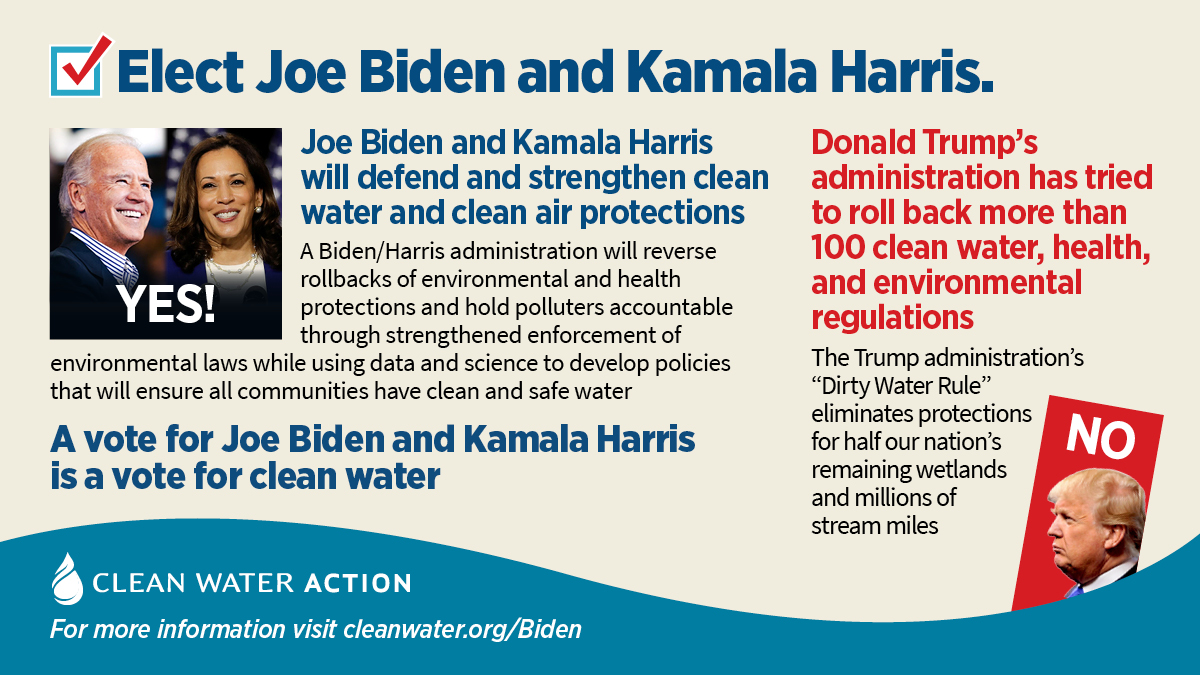
A Biden-Harris administration will use the power of the federal government to fight environmental injustice. Biden has committed to holding polluters accountable for the damage they do to communities. A Biden administration will restore our country’s global role in addressing climate change and has committed to significant investments in clean energy and to aggressive reductions in greenhouse gas emissions. Biden and Harris are committed to critical democracy reforms to ensure that people and community voices are not drowned out by money in politics, lack of ballot access, and ethics problems.
The bottom-line: Joe Biden and Kamala Harris will lead the way in restoring critical environmental and public health protections to safeguard our water and communities. It’s that simple.
Make sure when you cast your ballot, you cast it for Joe Biden and Kamala Harris, along with Clean Water Champions like Senator Ed Markey (MA), Rep. Jahana Hayes (CT Dist. 5) and Rep. Jim Langevin (RI Dist. 2).
For more information, visit this page.
Be a Clean Water Voter in 2020. You might cast your ballot differently this year. To make sure your vote gets counted, make a plan. That means doubling checking your voter registration status; deciding if you want to vote via absentee ballot, and knowing the rules; finding out if your polling location has changed; and more.
We’ve created a handy resource — learn more here.
Calling All Clean Water Voters!!!
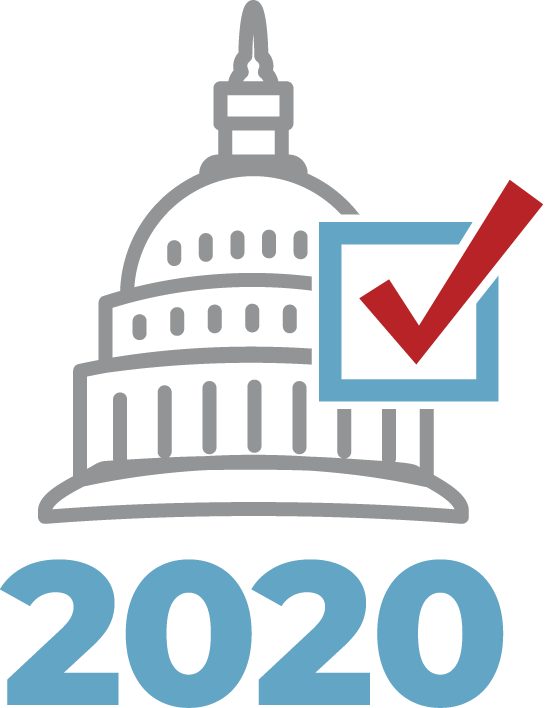
With mere weeks left until election day this fall, it is clear what is on the line for our health and the environment. The Trump Environmental Protection Agency has weakened or completely rolled back so many bedrock safeguards in laws like the Clean Water and Clean Air Acts — including the “Dirty Water Rule” that strips protections from smaller streams and wetlands. This affects the health of our communities in complex ways, including putting drinking water for millions at risk of pollution and destruction.The scope of the damage is hard to take in because it is so unprecedented. By summer 2020, the Trump administration had finalized or begun more than 100 policies rollbacks.
In February 2020, Clean Water Action joined a number of allies to declare that Donald Trump is the worst environmental president in history. The statement read:
“Donald Trump’s administration has unleashed an unprecedented assault on our environment and the health of our communities. His policies threaten our climate, air, water, public lands, wildlife, and oceans; no amount of his greenwashing can change the simple fact: Donald Trump has been the worst president for our environment in history. Unfortunately, our children will pay the costs of this president’s recklessness.”
And with a Republican majority in the U.S. Senate, groups like Clean Water Action have had little power to stop or even slow down the damage.
This moment in time is critical and our call to action is clear: 1. In “blue” states like Connecticut, Massachusetts and Rhode Island, it is imperative to run up a significant vote count for Joe Biden and Kamala Harris who support a strong environmental and climate justice platform, and 2. Voter engagement and turn out in key battleground states like Pennsylvania and Michigan is critical. That’s the only way to ensure clear majorities that will show overwhelming support for the Biden/Harris ticket and their environmental leadership. Without a commanding majority, it becomes more likely that the legitimacy of the election itself will be questioned by President Trump.
Please join in! Be a Clean Water Voter and vote early with our health and environment in mind. Encourage all in your circles to make a concrete plan to vote. Get more information here on your options for voting in your community.
And join Clean Water Action’s virtual phone bank to help elect clean water champions in the critical battleground state of Pennsylvania. Tuesday night is volunteer phone bank night! Every Tuesday leading up to the election, you can help mobilize Clean Water Voters in Pennsylvania from the comfort of your own home. For more information and to sign up to volunteer here.
Massachusetts Endorsements
November 3rd is election day — and it’s coming up soon! If you are voting early or by absentee ballot, it’s already here. With scientific consensus telling us that we must make massive, transformational changes to the global energy system now to avoid locking in catastrophic levels of climate pollution,1 fighting for climate action and climate justice has never been more urgent. Frontline communities in Massachusetts are already feeling the effects of a warming world, from increased flood risks to dangerously high temperatures.2 Your vote can make the difference between electing legislators who will give their all to fight for clean water, clean air and healthy communities, or those who will do nothing but uphold the status quo.
Bold, transformative change is a must this election, and Clean Water Action has endorsed candidates in Massachusetts who will be part of that change, from Congress to Beacon Hill. Now, we’re counting on you to go to the polls and be a voter for candidates who will fight for clean energy, healthy communities and justice for all!
When you vote this fall—vote for climate justice!
Find more information about how to vote safely at Clean Water Action’s voter guide and Safe Elections Massachusetts.
US Senate: Senator Ed Markey. Ed Markey is a proven champion of environmental justice: as Senator, Markey has fought to end construction of new coal plants, expand opportunities for affordable renewable energy production, and continues to push for a Green New Deal to address the climate crisis on the scale it requires. Markey’s victory in the primary is a massive victory for the environment — and he still needs your vote in the general election!
Yes on 2: Ranked Choice Voting. Clean Water Action Massachusetts also endorses Ballot Question 2, which would implement ranked choice voting across Massachusetts for state and federal elections. In a ranked choice voting system, voters get to rank all the candidates in a race, rather than choosing just one —meaning that voters no longer have to choose between the candidate they most believe in and the candidate most likely to be elected. This will allow candidates with a greater diversity of views and ideas to be successful, and help more progressive and environmentally-focused candidates make it to Beacon Hill! Democracy is strongest when more voices are heard — vote yes on Ballot Question 2 this November. Learn more about ranked choice voting here.
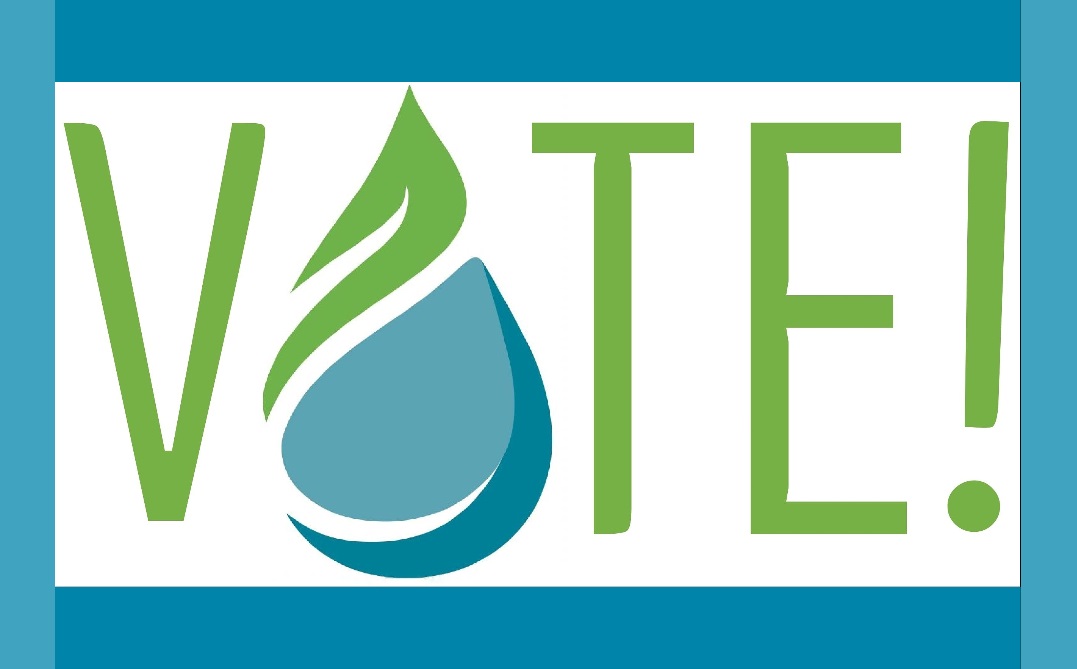
Congressional Endorsements
Rep. Jim McGovern (2nd Congressional District - Central & Western MA, Worcester, Greenfield)
Rep. Katherine Clark (5th Congressional District - Metro Boston & Metrowest, Malden, Cambridge, Framingham)
Rep. Ayanna Pressley (7th Congressional District - Metro Boston, Boston, Everett, Randolph)
Rep. Bill Keating (9th Congressional District - Southeast & Cape/Islands, Norwell, New Bedford, Barnstable)
Massachusetts State Legislature Endorsements
STATE SENATE:
Sen. Susan Moran (Plymouth and Barnstable - Kingston, Pembroke, Plymouth, Bourne, Falmouth, Sandwich)
Sen. Becca Rausch (Norfolk, Bristol, and Middlesex - Franklin, Millis, Needham, Norfolk, Plainville, Wellesle, Wrentham, Attleboro, North Attleborough, Natick, Sherborn, Wayland)
STATE HOUSE:
Adam Scanlon (14th Bristol - Attleboro)
Christina Eckert (2nd Essex - Boxford, Georgetown, Groveland, Haverhill, Merrimac, Newbury, Rowley, West Newbury)
Rep. Tram Nguyen (18th Essex - Andover, North Andover)
Rep. Carmine Gentile (13th Middlesex - Framingham, Marlborough, Sudbury, Wayland)
Rep. Danillo Sena (37th Middlesex - Acton, Ayer, Boxborough, Harvard, Lunenburg, Shirley)
Rep. Joan Meschino (3rd Plymouth - Hingham, Cohasset)
Rep. Patrick Kearney (4th Plymouth - Marshfield, Scituate)
Rep. Michelle DuBois (10th Plymouth - Bridgewater, Brockton, West Bridgewater)
Rep. Natalie Higgins (4th Worcester - Leominster)
If you’re looking for more information about voting on environmental issues this election, check out this Green Voter Guide, put together by our coalition partners at the Environmental League of Massachusetts.
1
2
Massachusetts
Legislative Round-Up
In Massachusetts, Clean Water Action has been working to pass strong climate legislation, an environmental justice bill, and bans on several toxic chemicals. The most exciting progress this year (so far — the session has been extended until December 31st) is in climate and environmental justice.
Both the House and Senate passed climate bills that commit Massachusetts to net zero greenhouse gas emissions by 2050 — with a 50% reduction by 2030.
The Senate bill (An Act Setting Next Generation Climate Policy-S.2500) creates a much more detailed planning process, establishing an independent Climate Commission to measure progress. It also puts in place a timeline for the adoption of economy-wide carbon pricing. Clean Water successfully advocated for stronger equity language, reporting requirements, and attention to vulnerable manufacturing sectors, workers and rural populations.
In a big win for Clean Water and its allies, the House climate bill (An Act Creating a Roadmap to a Clean and Thriving Economy-H.4933) was amended on the House floor to include language from environmental justice bills introduced by champions Rep. Liz Miranda (D-Roxbury), Rep Adrian Madaro (D-East Boston) and Rep. Michelle DuBois (D-Brockton). It codifies into law environmental justice protections, including requirements for environmental review and community review, for any adverse environmental use proposed within or near an environmental justice community.
These two bills are now before a conference committee that must reconcile their differences.
Environmental Health
Last session, both the House and the Senate passed “An Act to Protect Children, Families and Firefighters.” This bill bans 11 toxic flame retardants from being used in children’s products, residential upholstered furniture, bedding, mattresses, and window treatments. Unfortunately, Governor Baker vetoed the bill.
At the beginning of this session, Representative Marjorie Decker (D-Cambridge) and Senator Cynthia Stone Creem (D-Newton) promptly re-filed the Children and Firefighters Protection Act. The Joint Committee on Public Health gave a “favorable recommendation” to the bill in Spring 2019, and the Senate passed it unanimously the following fall. Both the House and Senate versions are now before the House Ways and Means Committee — where they have remained for over a year. Clean Water is still working to get this bill passed before the end of the year.
Clean Water Action also worked with Representative Jack Lewis (D-Framingham) and Senator Mike Moore (D-Millbury) to pass a bill banning PFAS from food packaging. Forty percent of paper plates, cups, and food wrappers are treated with PFAS (polyfluoroalkyl substances). These are persistent, toxic and bioaccumulative chemicals that migrate from food packaging into food and from food into our bodies, increasing the risk of a range of problems including immunosuppression, liver effects, high cholesterol, and certain cancers.
Carbon Nanotubes: Good guys? Bad guys?
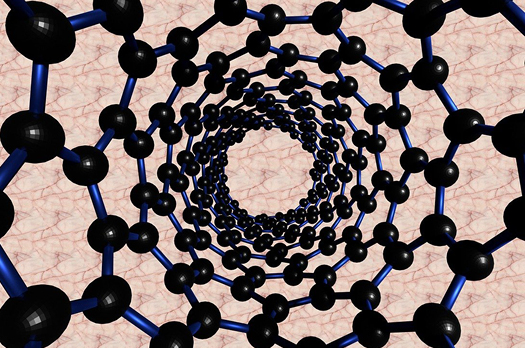
By Laura Spark, Climate and Health Advocate
Imagine a lightweight material that is a hundred times stronger than steel. Now imagine that material can conduct electricity, store energy, stop a bullet, filter contaminated water, and deliver drug treatments to cancer cells without harming adjacent tissues.
You may not have heard of carbon nanotubes (or CNTs), which are a scientific wonder substance, but they are probably already part of your life. They may be in your cell phone or computer, where they are used as semiconductors, or part of your bike frame, where they provide strength without weight. They could even be in your tires, helping improve handling on slick roadways.
The market for CNTs is expected to grow significantly in the upcoming decades. CNTs can provide the lightweight strength that modern windmills need. They can help batteries store the charge in an electric vehicle.
But there is a down side to CNTs that comes in the form of lung fibrosis, mostly lung cancer. There is also genotoxicity and the potential harm to a wide array of body systems, like the heart, kidney and brain. Worse, in vivo and in vitro studies show that carbon nanotubes can cause harm at very low levels. Some CNTs actually look like asbestos fibers — and they appear to act like asbestos as well, causing mesothelioma and other lung cancers.
Carbon nanotubes are, essentially, a bunch of carbon atoms stuck together and rolled into a tube. They can be long, short, rigid or curved. Other chemicals can be added to their surface. All of these variations can affect the way CNTs behave. Produced in batches, a handful of carbon nanotubes look like black soot. And, like soot, CNTs can be inhaled.
In products, CNTs are often embedded in a material, which theoretically contains them for an unspecified amount of time, making them safer. But what happens when tires with carbon nanotubes roll on highways — or when ground-up tires are turned into playground surfacing? Even when carbon nanotubes are bound into a material, they can be released over time through wear and tear. Eventually, as items reach the end of their life span and are discarded, what happens to carbon nanotubes as products break down?
The National Institute for Occupational Safety and Health has recommended protective measures for workers manufacturing and using CNTs. They also recommend that workers receive ongoing medical monitoring, with a focus on lung diseases. Epidemiological research is underway to determine if workers who make and use CNTs have higher levels of lung disease.
As with many promising technologies, CNTs have the potential for good and for harm.
Clean Water Action has submitted a petition, asking Massachusetts to list carbon nanotubes on its list of Higher Hazardous Substances. If CNTs are added to the list, facilities making and using CNTs will need to submit annual reports to the Massachusetts Department of Environmental Protection.
Reporting does not solve the problem of hazard, but it is a first step in understanding it.
Tackling PFAS Pollution!
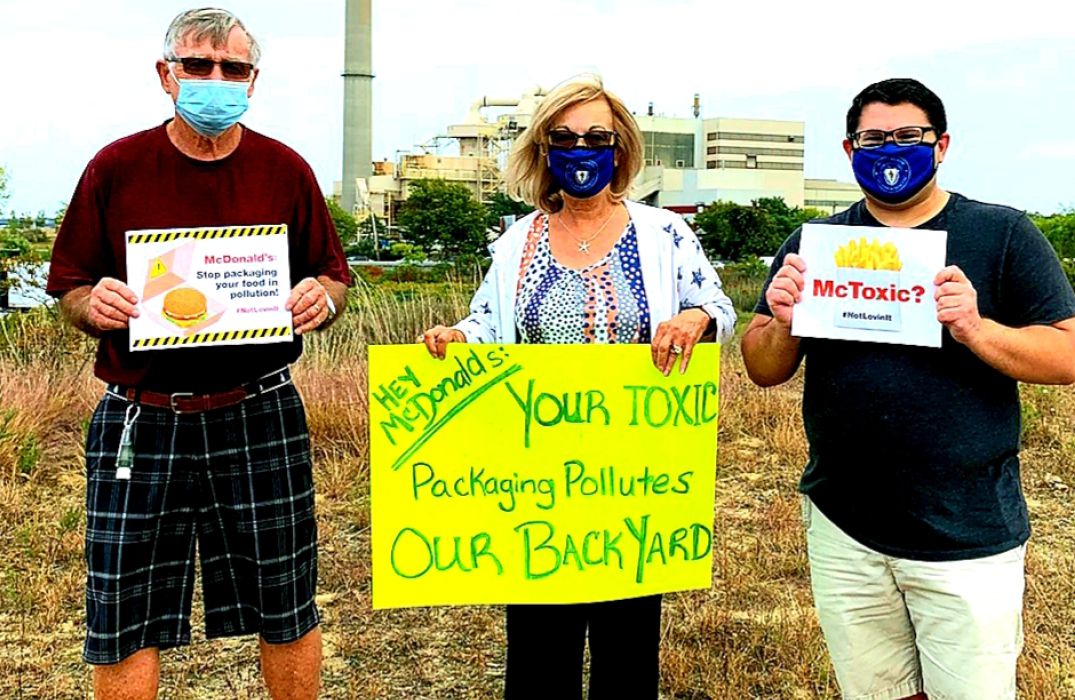
Toxic PFAS chemicals are found in ground and drinking water sources across the country. Recent reports indicate that 110 million Americans have PFAS chemicals in their drinking water. Across New England, contamination has been found on farms, near landfills, in private wells, ground and drinking water sources and near military bases. Connecticut is expanding monitoring after two disastrous spills of firefighting foam into the Farmington River and positive tests near landfills in the state. Rhode Island is addressing PFAS contamination in part by fighting for a landmark PFAS ban in food packaging and Clean Water Action’s Massachusetts team is working on PFAS contaminated drinking water in Westfield, Barnstable and Ayer, MA.
PFAS chemicals are used to make products water, grease and stain resistant as well as anti-stick. They are found in firefighting foam, clothing and textiles, anti-stick cookware, personal care products and food packaging. PFAS chemicals are known as forever chemicals as they don’t break down in the environment. Discarded products end up in landfills and incinerators contaminating air, soil and water sources. PFAS chemicals are linked to certain cancers, thyroid disruption, low birth weights, reproductive disorders and weaken our immune systems.
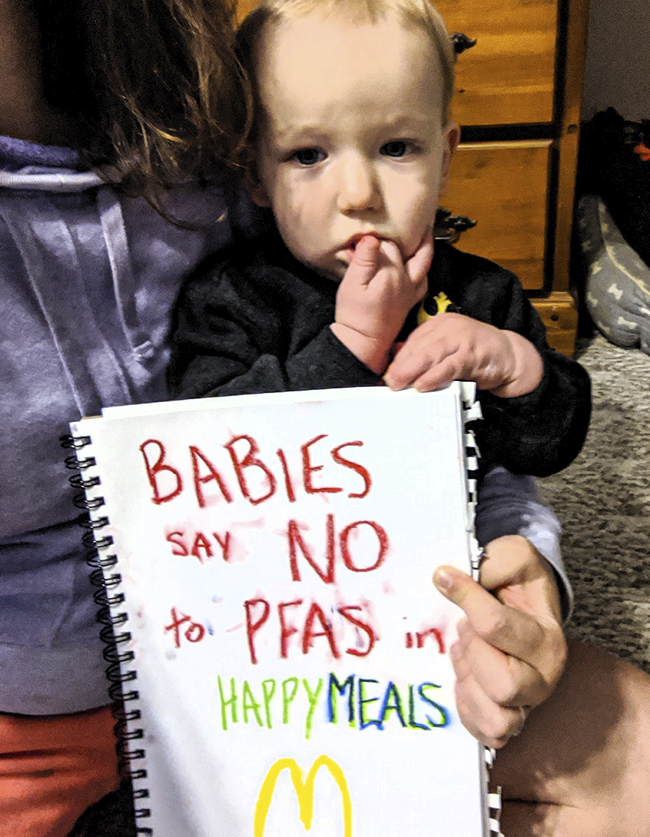
Clean Water Action is leading efforts to restrict the use of these chemicals on many fronts including advocating for bans in our state legislatures and driving market changes through the Mind the Store Campaign. The recent “Packaged in Pollution” report highlighted the problem of PFAS in food packaging, a major source of exposure and pollution as these single use products end up in landfills or incinerators. With allies across the country, Clean Water Action’s team in Connecticut, Massachusetts and Rhode Island targeted McDonald’s — the world’s largest fast-food chain, mobilizing actions and calls to McDonald’s CEO — urging him to shift to safer alternatives. Check out some of the highlights below.
Connecticut
Connecticut has been a leader in setting bold carbon reduction goals. The state has a mandate to achieve 100% clean renewable electricity by 2040 and rapidly electrify the transportation system. Connecticut is a signatory to the regional Transportation Climate Initiative and the diverse, expanded Governor’s Council on Climate Change has been directed to provide recommendations to the Governor on how to achieve these targets by end of 2020 while creating comprehensive plans for mitigation and adaptation.
Clean Water Action is proud that Connecticut has been a leader yet dismayed that a plan to permit a new fracked gas power plant in northeastern Connectcut is moving forward. Clean Water Action, along with other allies, is fighting hard to stop this destructive plan!
NTE, the Florida based developer, has been working for years to move this project forward. During a final phase of the permitting process, Connecticut Department of Energy & Environmental Protection (DEEP) announced plans to give the proposed Killingly fracked gas power plant a permit to discharge up to 90,000 gallons of treated wastewater daily into the Quinebaug River. Despite being treated, the wastewater will still contain harmful pollutants, including heavy metals and other toxic chemicals.
Clean Water Action and allies are working hard to urge Connecticut’s Governor to do everything possible to put a halt to a plant that imports fracked gas, increases reliance on fossil fuels, pollutes pristine waterways, and flies in the face of achieving the state’s carbon reduction goals. Connecticut Director, Anne Hulick, states “we simply do not need another fracked gas power plant in the northeast.”
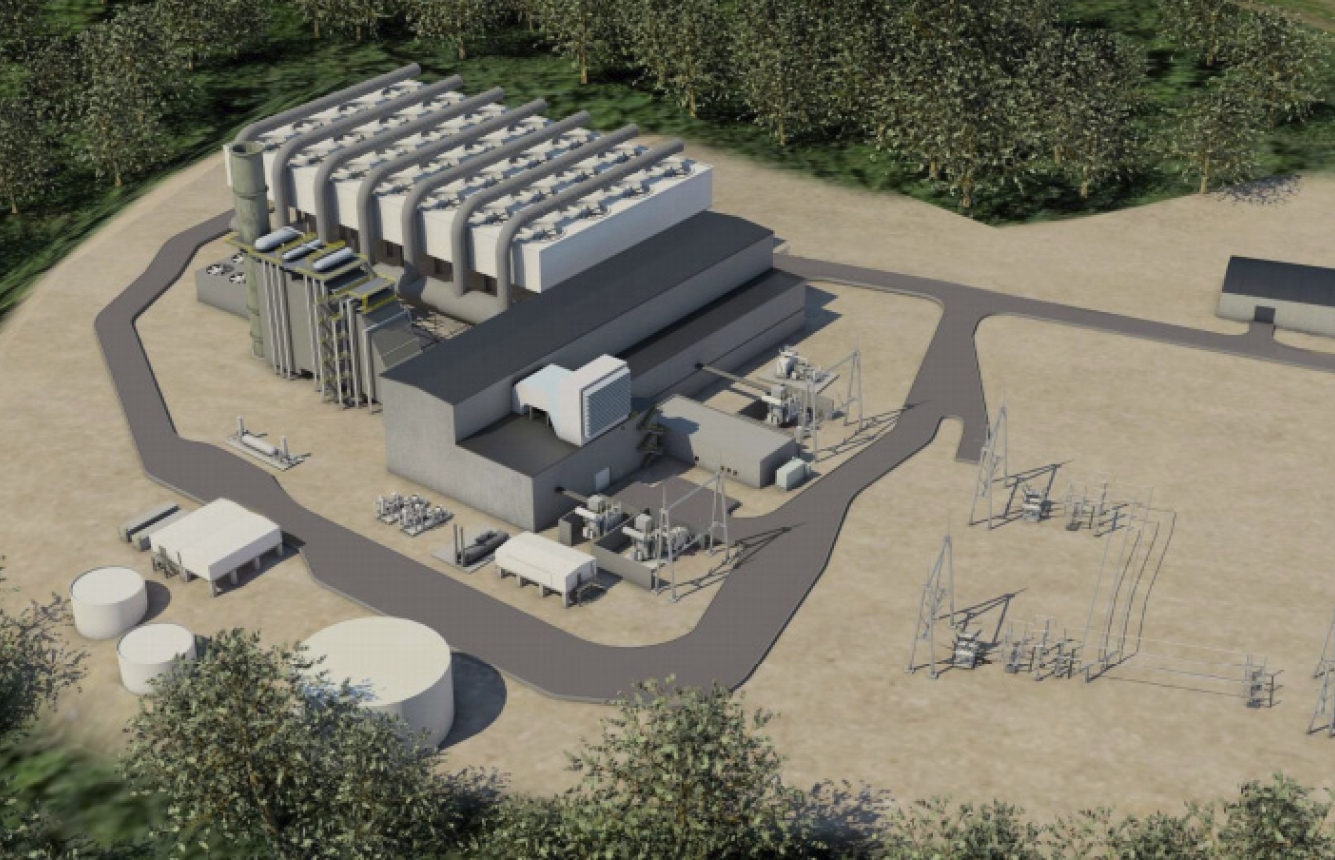
Clean Water Action met with local residents to hear their concerns and its phone canvass is mobilizing members to send emails and letters to the Governor and the Commissioner of DEEP.
Clean Water Action members care about these issues and are concerned that this plant is moving forward without a lot of public attention. Kerem Gokmen, the organization’s Pittsburgh phone canvass director, states “our phone canvass team reaches out to organize our members in CT on important local issues. Pretty much everyone we’ve talked to in the state is against the Killingly power plant and have voiced their concerns to their state leaders through email comments or physical letters.”
Clean Water Action will continue organizing the public to stop this dangerous plant.
“Another fracked gas power plant? No, Thanks.” asserted Andy Bauer, Clean Water Action’s National board member and CT resident. “Look, we’ve seen this movie before. We know it ends with more pollution, higher electricity prices, and more pipelines. Can we just advance the story to 2020 and go with renewables?”
Rhode Island
Climate Champions Win Big in Rhode Island Primary Election
The Rhode Island General Assembly looks to be getting a bit greener after this year’s primary elections.
Rhode Island held its statewide primary election on September 8th. Though candidates will face opponents in the General Election on November 3rd, primaries in Rhode Island typically decide who will ultimately win positions in the State House and State Senate. Due to the COVID-19 pandemic, this election looked a bit different than in past years. Usually, the winners are announced by the end of the night or early the next morning but this year, voters had to wait a few days. So folks spent a few days biting their nails and constantly refreshing the Board of Elections results page. But it was worth the wait (this is also a preview of what the Presidential election and races for important US Senate and House seats will look like).
When the dust settled and the last mail ballot was counted, Clean Water Action saw 18 of its 19 endorsed candidates with primary opponents win their races. This includes nine candidates that were either seeking an open seat or taking on more conservative incumbents. A number of incumbent champions fend off primary challengers and move on to the general election. Winning their primaries were:
Municipal Races
Maria Bucci (D), Mayor, Cranston
State Senate
Sam Bell (D), District 5
Tiara Mack (D), District 6
Meghan Kallman (D), District 15
Jonathon Acosta (D), District 16
Jeanine Calkin (D), District 30
Kendra Anderson (D), District 31
Alana DiMario (D), District 36
V. Susan Sosnowski (D), District 37
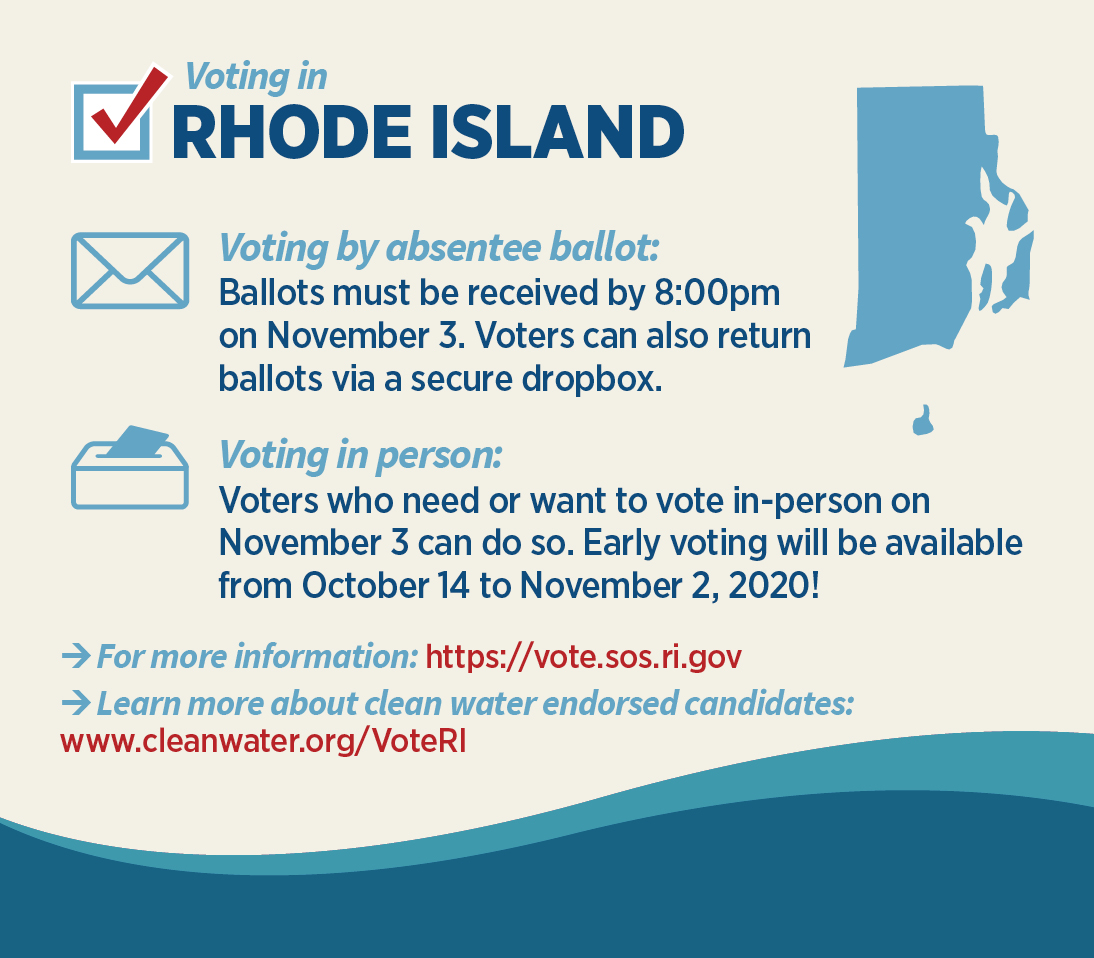
State Representative
David Morales (D), District 7
Grace Diaz (D), District 11
Brandon Potter (D), District 16
Joseph McNamara (D), District 19
Teresa Tanzi (D), District 34
Leonela Felix (D), District 61
Michelle McGaw (D), District 71
Terri Cortvriend (D), District 72
Deborah Ruggiero (D), District 74
After two years of inaction on the climate crisis, on addressing our looming waste and plastic pollution problems, and protecting the state’s valuable open space and forests, it is clear that Rhode Islanders are fed up and are demanding action on the environment, public health, and all of the other intersectional issues.
Each of these endorsed candidates has pledged to prioritize bills that establish mandatory carbon emissions reductions, eliminate PFAS from food packaging and our soils and waters, and address environmental and social injustices, among others.
State leaders have dragged their feet on these issues for too long, and voters made it clear that the time for inaction and excuses has run out. Clean Water Action congratulates all of these candidates on their primary victories and looks forward to supporting them — alongside number of additional general election endorsees — in November.
To learn more about clean water endorsed candidates, visit this page
An Interview with Providence’s Emily Koo
Clean Water Action has begun partnering with local cities and towns to reduce exposure to toxic chemicals by residents and municipal employees. Our first partnership in this work in Rhode Island was with the City of Providence. Emily Koo, the Sustainability and Strategy Manager with the Office of Sustainability for the City of Providence, sat down with to answer some questions about her work on environmentally preferable purchasing and reducing pesticide use in Providence.
What’s your title?
Sustainability Strategy Manager
How long have you worked for the Office of Sustainability in PVD?
9 months! Although, I also interned in the office in 2012 and supported the office in another city role from 2013-2015. It’s great to be back!
What is your favorite thing about living and working in Providence/Rhode Island?
It’s nice to live in a city with an urban landscape, that, at least before the pandemic, is small enough to run into people you know around town.
What is your favorite place in RI to enjoy the outdoors?
In Providence, Neutaconkanut Hill for hiking. Across the whole state, Pettaquamscutt River for paddling, where it opens up into the Bay.
What nature-related book should everyone read?
Rising by Elizabeth Rush. Beautiful and haunting stories of climate change.
Why do you think it’s important for the city to champion pesticide free turf care?
For the health of our communities! Our Parks Department has done an excellent job of limiting exposure to chemical-heavy pesticide and fertilizer treatments as well as the use of unsafe building materials in our public green spaces. We have a report highlighting those efforts coming out later this fall. We’ll also launch a Pesticide Free PVD campaign targeted at reducing the use of pesticides in residential lawns and gardens, as well as other toxins in the home.
What is one thing that homeowners could do in/outside of their homes to limit their impact on public health/the environment?
Before reaching for pesticides for your lawn or garden or home, consider the health impacts of such chemicals — on human health, on pets and other animals, on pollinators and other beneficial insects and birds, on our waterways.
Why do you think it’s important for the city to have environmentally preferable purchasing practices?
To lead by example and drive the market towards sustainable goods and services. Doing so prioritizes the health of our employees and reduces the lifecycle environmental impacts of the products that we purchase.
How will EPP impact vulnerable communities in Providence?
The way things are made and the products we purchase have a huge impact on our environment and our health. And we know that frontline and under-resourced communities will suffer the most from supply chain impacts. Think about where our energy comes from, where our waste ends up, where the vehicles that transport goods pass through.
